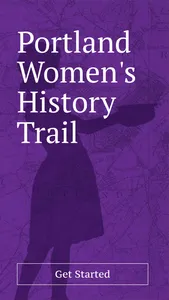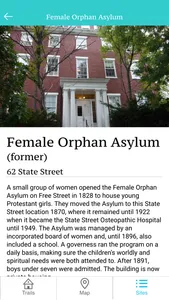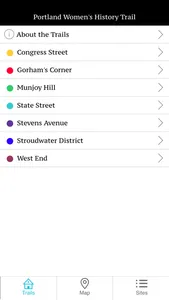Photos and text reveal the history of women in work, education, politics, religion, and education, in public space and private space. Maps will guide you through seven walking trails, and two centuries of history of women in Portland, Maine.
Why a history trail? Why do we need to walk to find history? Can't we just look it up in books or experience it on television or read about it online? And why a women's history trail?
Maine author Sarah Orne Jewett expressed the answer to the first question after she visited the home of Charlotte and Emily Brontë on the edge of the Yorkshire moors: "Nothing you ever read about them can make you know them until you go there,” she said. “Never mind people who tell you there is nothing to see in the place where people lived who interest you. You always find something of what made them the souls they were, and, at any rate, you see their sky and their earth."
The second question is easily answered as well. Without the work, contributions, and insights of women, Portland—and the world—would be a very different place. Because women’s lives, in many ways, have been different from men’s lives, so has women’s history been distinct. By walking this trail, you can begin to connect with the lives of your figurative sisters, mothers, aunts, and great grandmothers in all the diversity of backgrounds that these women represent. You will never see the city of Portland in the same way again.
The Portland Women's History Trail is divided into seven walks and introduces women from (mainly) two centuries in a variety of settings, activities, and backgrounds. The two downtown walks, Congress Street and State Street, can be joined into one walk or traveled separately. The three neighborhood walks are Munjoy Hill, the West End and Gorham’s Corner. You need to drive to the historic Stroudwater District on outer Congress Street but can walk that part of the trail. Likewise, you need to drive to the Stevens Avenue portion of the trail but can walk the area.
The Trail also intersects at different points with three other walks of diverse ethnicity: the Portland Freedom Trail, highlighting Portland’s African-American and anti-slavery history, primarily on Munjoy Hill; the Chinese-American Walking Tour, with sites along the Congress Street and part of State Street walks and some of which abut the Munjoy Hill walk; and the Maine Irish Heritage Trail, which features several of the same sites on all of the same Women’s Trail walks except Stroudwater. These three trails complement the Women’s walks with their own rich history.
Why a history trail? Why do we need to walk to find history? Can't we just look it up in books or experience it on television or read about it online? And why a women's history trail?
Maine author Sarah Orne Jewett expressed the answer to the first question after she visited the home of Charlotte and Emily Brontë on the edge of the Yorkshire moors: "Nothing you ever read about them can make you know them until you go there,” she said. “Never mind people who tell you there is nothing to see in the place where people lived who interest you. You always find something of what made them the souls they were, and, at any rate, you see their sky and their earth."
The second question is easily answered as well. Without the work, contributions, and insights of women, Portland—and the world—would be a very different place. Because women’s lives, in many ways, have been different from men’s lives, so has women’s history been distinct. By walking this trail, you can begin to connect with the lives of your figurative sisters, mothers, aunts, and great grandmothers in all the diversity of backgrounds that these women represent. You will never see the city of Portland in the same way again.
The Portland Women's History Trail is divided into seven walks and introduces women from (mainly) two centuries in a variety of settings, activities, and backgrounds. The two downtown walks, Congress Street and State Street, can be joined into one walk or traveled separately. The three neighborhood walks are Munjoy Hill, the West End and Gorham’s Corner. You need to drive to the historic Stroudwater District on outer Congress Street but can walk that part of the trail. Likewise, you need to drive to the Stevens Avenue portion of the trail but can walk the area.
The Trail also intersects at different points with three other walks of diverse ethnicity: the Portland Freedom Trail, highlighting Portland’s African-American and anti-slavery history, primarily on Munjoy Hill; the Chinese-American Walking Tour, with sites along the Congress Street and part of State Street walks and some of which abut the Munjoy Hill walk; and the Maine Irish Heritage Trail, which features several of the same sites on all of the same Women’s Trail walks except Stroudwater. These three trails complement the Women’s walks with their own rich history.
Show More




